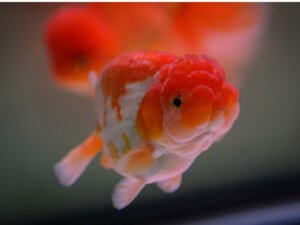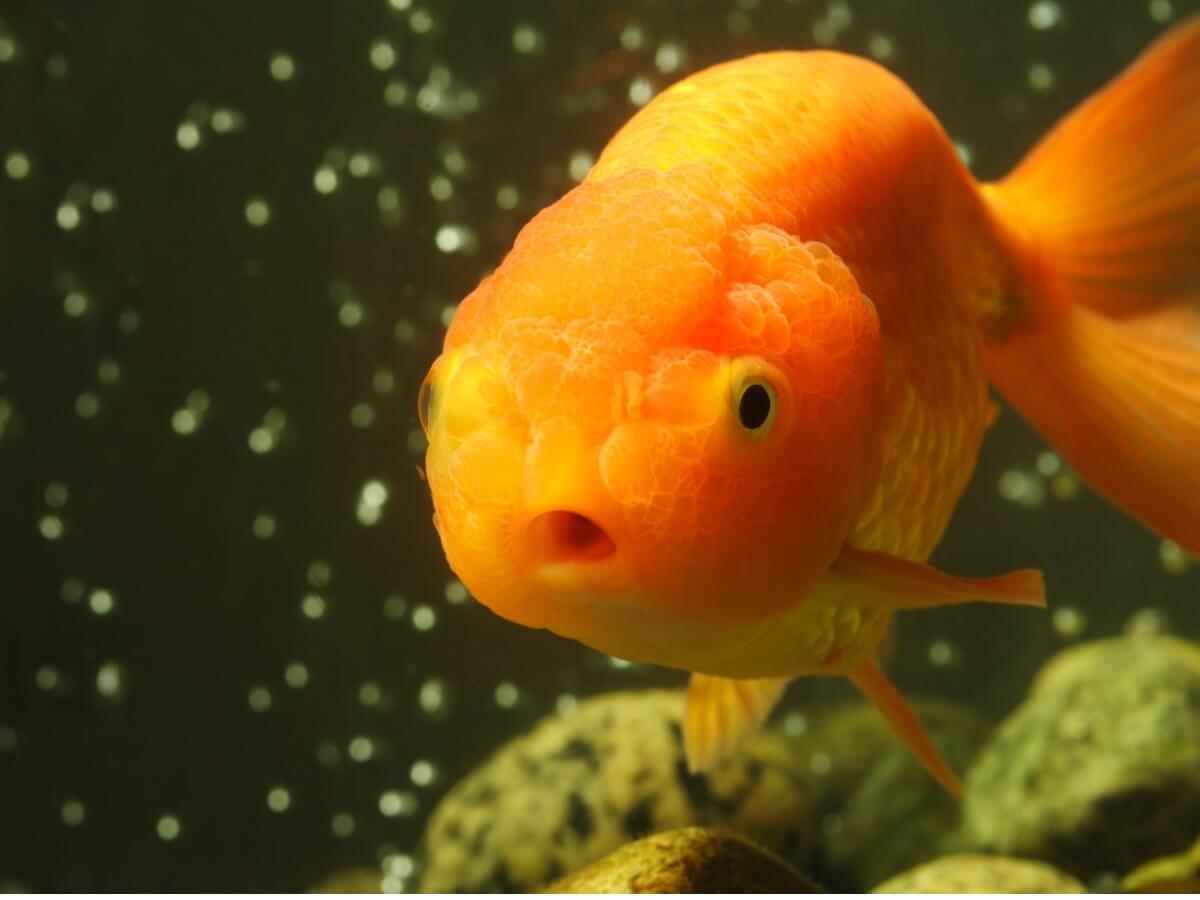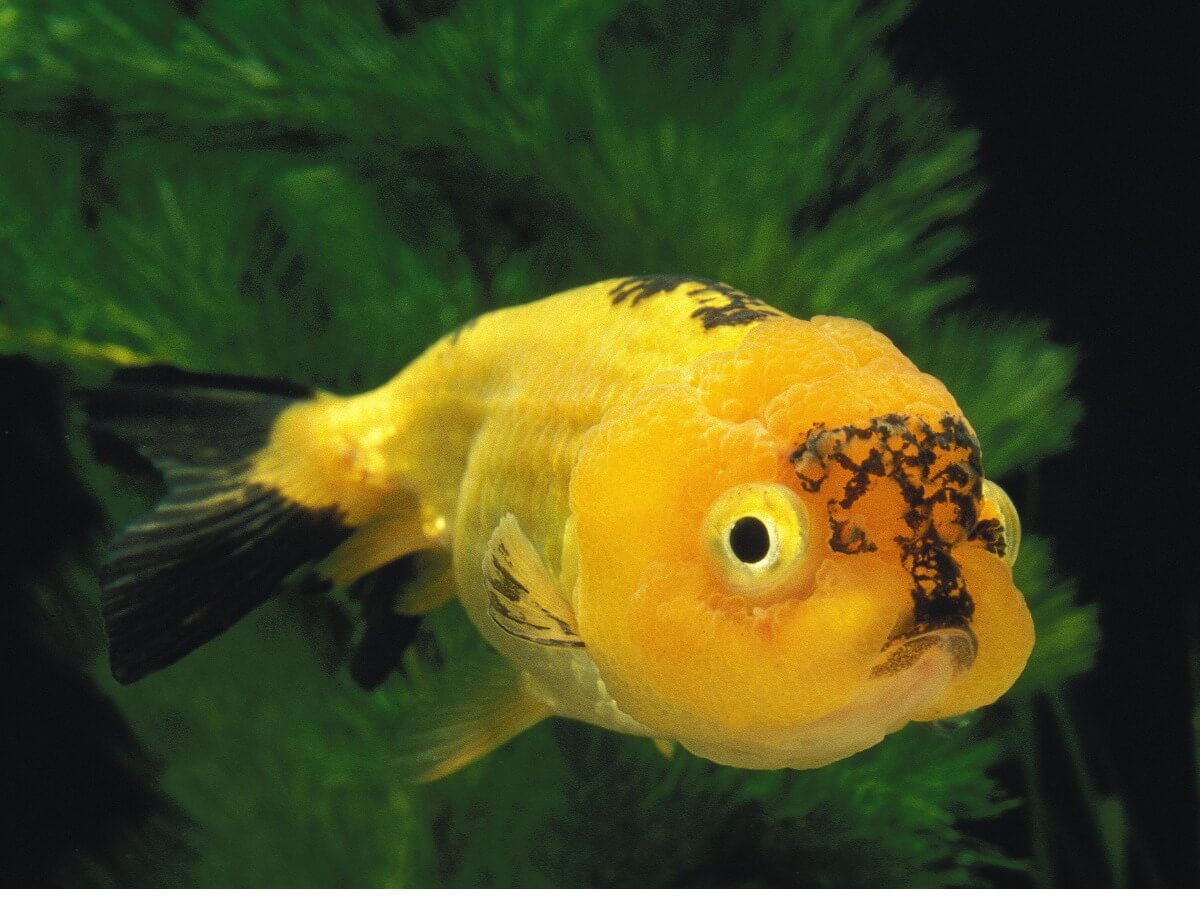Lionhead Fish: Habitat, Characteristics and Care


Written and verified by the biologist Cesar Paul Gonzalez Gonzalez
Goldfish are considered the most famous ornamental fish. They’re native to Asia, where they were domesticated and exported to other countries. Due to this situation, the species was divided into varieties, each with its own unique characteristics. The lionhead fish gets its name from its striking head crown, which resembles the mane of a lion.
Due to their beautiful appearance, and as they’re easy fish to keep – goldfish (Carassius auratus) are found almost everywhere in the world. Specifically, the golden colors, compact size, and showy head have earned the lionhead fish the reputation of being one of the most popular varieties in the aquarium. Read on to learn more about it.
Habitat of the lionhead fish
Normally, these fish are considered inhabitants of temperate and cold waters, so they live well in temperature ranges of 15 to 25 degrees Celsius (59 – 77 F). Its origins are in Asia, but it’s possible to see them in most aquariums, as it isn’t very difficult to look after them.
They’re freshwater animals with not much movement, as they like to stay in areas with a little mud. In fact, they’re close relatives of carp, so they have similar preferences. There’s even a good chance that a goldfish and a common carp can hybridize.
In general, these fish do very well in pond environments, where some plants serve as their food. The best option would be to have a muddy substrate in these ecosystems, but it’s difficult to maintain their health with these conditions.

Physical characteristics
The length of its body can reach 20 centimeters (8 inches), although it normally varies between 15 and 18 centimeters (6 and 7 inches). Its body is round in shape, with a slight curvature in the back, and it swims quite slowly. Their fins have the following physical conformation:
- A pair of pectoral fins: On each side, just next to its “mane”.
- A pair of anal fins: In the lower part of the body.
- Caudal fin
- An anal fin: Found just above the tail.
The lionhead fish is characterized by two main aspects things: its head that grows in the form of a lump and the lack of a dorsal fin. This is important, as it can be confused with the Oranda variety, which does have a dorsal fin. On the other hand, it also closely resembles the Ranchu variety, which is almost identical but with a more curved back than the lionhead.
The most common colors are golden tones, with combinations of white, red, and yellow. However, it can also have any other coloration that’s typical of goldfish.
Lionhead fish behavior
This fish is a very calm animal, due to its habitat and its inability to swim fast. If it becomes stressed, its usual reflex is to keep hidden. However, this doesn’t mean that it’s shy. In fact, Carassius auratus is usually a sociable species, which, in fish tanks, develops better in the company of other fish of the same group.
Life expectancy
In general, experts state that lionhead fish can live in captivity for 5 to 10 years. However, this will depend on the maintenance and care they receive. This is because interaction with other fish can cause problems, always because of the other species. Fin bites are common among incompatible fish.
For this same reason, it’s recommended to carefully select the pet’s companions.
Lionhead fish feeding
In their natural environment, these organisms are omnivores, so they consume plants, insects, crustaceans, zooplankton and detritus. In aquariums, they’re fed live food or frozen food, and they also accept commercial flake-type food. It should be noted that these animals can also eat the plants in the aquarium.
Lionhead fish reproduction
The group of goldfish reaches maturity after one year of life. Two-year-old females are used commercially, as the larger they are, the more eggs they can lay. Also, most varieties don’t show all their physical characteristics until they reach a certain age.
In the wild, these animals carry out their spawning in spring, between February and May. However, they can be conditioned to do so at any time of the year. What’s more, some studies published in the scientific journal Hormones and Behavior have tested the use of hormones to promote this.
Fertilization and spawning
For fertilization, the females are chased by several males on the surface of the water body. While “escaping”, they release their eggs to the environment, with which the males take advantage of to fertilize them. Upon completion, the fertilized eggs fall to the bottom of the water, where they adhere to surfaces and begin their development.
Aquarium care for lionhead fish
The tank must have at least 40 liters of water for each fish that you want to have. Meanwhile, the internal structure of the aquarium will need to have thick soil, which can be achieved by including suitable aquarium gravel or sand. In addition, the use of an oxygenating pump and filter are necessary to keep the water in optimal conditions.
Periodic water changes are necessary, so we recommend that you do it at least twice a week. With regard to water quality, the following criteria must be met:
- Temperature: 18 – 24 ° C (optimal).
- Oxygenation level: 5 mg / L (minimum).
- Nitrites and ammonia: <0.05 mg / L.
- pH: 7 (optimal).
This species usually resists worse conditions than those mentioned, but, for its health and quality of life, it’s better to keep them at the appropriate values. Remember that in the world of pets, survival isn’t the same as living.
Cohabitation with other species
There’s no restriction regarding having goldfish with other types of fish. However, we recommend that they aren’t fast species. This could cause problems, due to the slow swimming of lionhead fish. Stress is very common when this species is placed with overly active animals.
State of conservation
Formally, this species isn’t in any degree of danger, due to its care in aquariums and reproduction in captivity. Moreover, on the contrary, goldfish have the potential to become an invasive species, because they’re able to withstand water in unfavorable conditions.
However, the lionhead variant may not fit this case, as it’s impaired in its mobility, preventing it from easily surviving in the wild. Also, it’s important to note that the goldfish variants come from selective crosses, in which humans decide which characteristics are more “beautiful”, in a similar way to what happens with dogs.

Remember that, even though it’s an “easy” species to keep, that doesn’t mean that it should live in the worst possible conditions. It should be borne in mind that having a pet involves investing in time, space, and money, so it isn’t an easy task. If you’re ready to take on the challenge, follow the recommendations and give your pet the best possible life.
Goldfish are considered the most famous ornamental fish. They’re native to Asia, where they were domesticated and exported to other countries. Due to this situation, the species was divided into varieties, each with its own unique characteristics. The lionhead fish gets its name from its striking head crown, which resembles the mane of a lion.
Due to their beautiful appearance, and as they’re easy fish to keep – goldfish (Carassius auratus) are found almost everywhere in the world. Specifically, the golden colors, compact size, and showy head have earned the lionhead fish the reputation of being one of the most popular varieties in the aquarium. Read on to learn more about it.
Habitat of the lionhead fish
Normally, these fish are considered inhabitants of temperate and cold waters, so they live well in temperature ranges of 15 to 25 degrees Celsius (59 – 77 F). Its origins are in Asia, but it’s possible to see them in most aquariums, as it isn’t very difficult to look after them.
They’re freshwater animals with not much movement, as they like to stay in areas with a little mud. In fact, they’re close relatives of carp, so they have similar preferences. There’s even a good chance that a goldfish and a common carp can hybridize.
In general, these fish do very well in pond environments, where some plants serve as their food. The best option would be to have a muddy substrate in these ecosystems, but it’s difficult to maintain their health with these conditions.

Physical characteristics
The length of its body can reach 20 centimeters (8 inches), although it normally varies between 15 and 18 centimeters (6 and 7 inches). Its body is round in shape, with a slight curvature in the back, and it swims quite slowly. Their fins have the following physical conformation:
- A pair of pectoral fins: On each side, just next to its “mane”.
- A pair of anal fins: In the lower part of the body.
- Caudal fin
- An anal fin: Found just above the tail.
The lionhead fish is characterized by two main aspects things: its head that grows in the form of a lump and the lack of a dorsal fin. This is important, as it can be confused with the Oranda variety, which does have a dorsal fin. On the other hand, it also closely resembles the Ranchu variety, which is almost identical but with a more curved back than the lionhead.
The most common colors are golden tones, with combinations of white, red, and yellow. However, it can also have any other coloration that’s typical of goldfish.
Lionhead fish behavior
This fish is a very calm animal, due to its habitat and its inability to swim fast. If it becomes stressed, its usual reflex is to keep hidden. However, this doesn’t mean that it’s shy. In fact, Carassius auratus is usually a sociable species, which, in fish tanks, develops better in the company of other fish of the same group.
Life expectancy
In general, experts state that lionhead fish can live in captivity for 5 to 10 years. However, this will depend on the maintenance and care they receive. This is because interaction with other fish can cause problems, always because of the other species. Fin bites are common among incompatible fish.
For this same reason, it’s recommended to carefully select the pet’s companions.
Lionhead fish feeding
In their natural environment, these organisms are omnivores, so they consume plants, insects, crustaceans, zooplankton and detritus. In aquariums, they’re fed live food or frozen food, and they also accept commercial flake-type food. It should be noted that these animals can also eat the plants in the aquarium.
Lionhead fish reproduction
The group of goldfish reaches maturity after one year of life. Two-year-old females are used commercially, as the larger they are, the more eggs they can lay. Also, most varieties don’t show all their physical characteristics until they reach a certain age.
In the wild, these animals carry out their spawning in spring, between February and May. However, they can be conditioned to do so at any time of the year. What’s more, some studies published in the scientific journal Hormones and Behavior have tested the use of hormones to promote this.
Fertilization and spawning
For fertilization, the females are chased by several males on the surface of the water body. While “escaping”, they release their eggs to the environment, with which the males take advantage of to fertilize them. Upon completion, the fertilized eggs fall to the bottom of the water, where they adhere to surfaces and begin their development.
Aquarium care for lionhead fish
The tank must have at least 40 liters of water for each fish that you want to have. Meanwhile, the internal structure of the aquarium will need to have thick soil, which can be achieved by including suitable aquarium gravel or sand. In addition, the use of an oxygenating pump and filter are necessary to keep the water in optimal conditions.
Periodic water changes are necessary, so we recommend that you do it at least twice a week. With regard to water quality, the following criteria must be met:
- Temperature: 18 – 24 ° C (optimal).
- Oxygenation level: 5 mg / L (minimum).
- Nitrites and ammonia: <0.05 mg / L.
- pH: 7 (optimal).
This species usually resists worse conditions than those mentioned, but, for its health and quality of life, it’s better to keep them at the appropriate values. Remember that in the world of pets, survival isn’t the same as living.
Cohabitation with other species
There’s no restriction regarding having goldfish with other types of fish. However, we recommend that they aren’t fast species. This could cause problems, due to the slow swimming of lionhead fish. Stress is very common when this species is placed with overly active animals.
State of conservation
Formally, this species isn’t in any degree of danger, due to its care in aquariums and reproduction in captivity. Moreover, on the contrary, goldfish have the potential to become an invasive species, because they’re able to withstand water in unfavorable conditions.
However, the lionhead variant may not fit this case, as it’s impaired in its mobility, preventing it from easily surviving in the wild. Also, it’s important to note that the goldfish variants come from selective crosses, in which humans decide which characteristics are more “beautiful”, in a similar way to what happens with dogs.

Remember that, even though it’s an “easy” species to keep, that doesn’t mean that it should live in the worst possible conditions. It should be borne in mind that having a pet involves investing in time, space, and money, so it isn’t an easy task. If you’re ready to take on the challenge, follow the recommendations and give your pet the best possible life.
All cited sources were thoroughly reviewed by our team to ensure their quality, reliability, currency, and validity. The bibliography of this article was considered reliable and of academic or scientific accuracy.
- Hulata, G. (1995). A review of genetic improvement of the common carp (Cyprinus carpio L.) and other cyprinids by crossbreeding, hybridization and selection. Aquaculture, 129(1-4), 143-155.
- Salazar, S. K., Pérez, J. E., & Alfonsi, C. (2008). Introducción y extracción de peces ornamentales y especies de invertebrados acuáticos en Venezuela. SABER. Revista Multidisciplinaria del Consejo de Investigación de la Universidad de Oriente, 20(2), 139-148.
- Copa Yujra, C. A. (2011). Evaluación del crecimiento de tres variedades de peces Goldfish (Carassius auratus) en agua fria bajo condiciones controladas (Doctoral dissertation).
- Najim, S., Al-Mudhaffar, R. A., & Jassim, F. K. (2012). Some reproductive character of the fantail goldfish (Carassius auratus auratus) female from rearing pond in Basrah, southern Iraq. Iraqi Journal of Aquaculture, 9(1), 83-94.
- Watson, C. A., Hill, J. E., & Pouder, D. B. (2004). Species profile: Koi and goldfish. Southern Regional Aquaculture Center.
- Rylková, K., Kalous, L., Šlechtová, V., & Bohlen, J. (2010). Many branches, one root: first evidence for a monophyly of the morphologically highly diverse goldfish (Carassius auratus). Aquaculture, 302(1-2), 36-41.
- Smartt, J. (2008). Goldfish varieties and genetics: handbook for breeders. John Wiley & Sons.
This text is provided for informational purposes only and does not replace consultation with a professional. If in doubt, consult your specialist.








